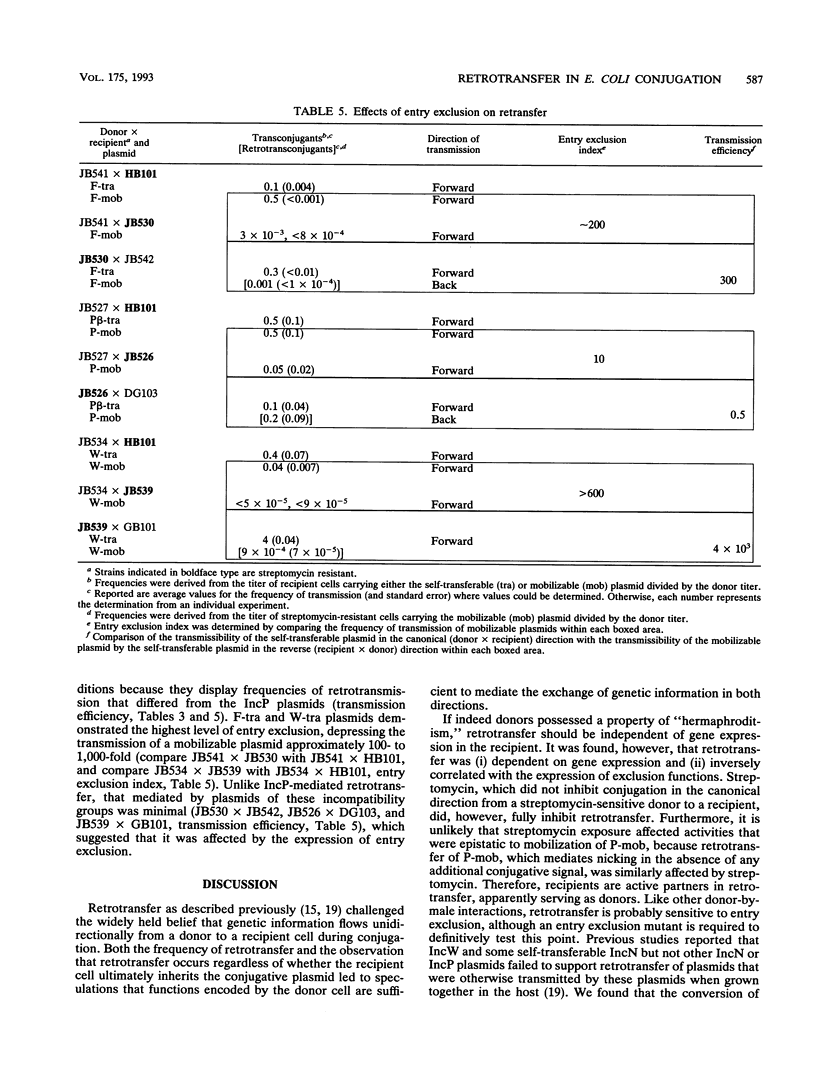Abstract
DNA can be transferred among eubacteria and to plants and fungi by related, plasmid-mediated processes collectively referred to as bacterial conjugation. Conjugation occurs between cells in contact with one another and results in the unidirectional delivery of DNA from a bacterial donor to a recipient. Recent experiments that have reexamined the directionality of DNA flow during conjugation have come to different conclusions, some suggesting that genetic material also flows from recipient cells into the donor and that this process, termed retrotransfer, is likewise directed by donor-encoded functions. Given that bacteria are perhaps united with all living creatures by conjugation, the possibility of gene flow into donor bacteria during conjugation raises interesting evolutionary and biocontainment issues. Here we report that plasmid transmission from bacterial recipients to donors is not a donor-mediated event. Movement of genetic material from recipients to donors was inhibited by streptomycin, which does not inhibit the conjugative donor, indicating that retrotransfer requires gene expression in recipients. Furthermore, retrotransfer was reduced in matings mediated by plasmids that encode strong entry exclusion, to a similar degree as matings between two donors. Therefore we suggest that retrotransfer is in fact newly initiated conjugation between transconjugants and donors.
Full text
PDF





Selected References
These references are in PubMed. This may not be the complete list of references from this article.
- Bolland S., Llosa M., Avila P., de la Cruz F. General organization of the conjugal transfer genes of the IncW plasmid R388 and interactions between R388 and IncN and IncP plasmids. J Bacteriol. 1990 Oct;172(10):5795–5802. doi: 10.1128/jb.172.10.5795-5802.1990. [DOI] [PMC free article] [PubMed] [Google Scholar]
- Boyer H. W., Roulland-Dussoix D. A complementation analysis of the restriction and modification of DNA in Escherichia coli. J Mol Biol. 1969 May 14;41(3):459–472. doi: 10.1016/0022-2836(69)90288-5. [DOI] [PubMed] [Google Scholar]
- Cohen M. L. Epidemiology of drug resistance: implications for a post-antimicrobial era. Science. 1992 Aug 21;257(5073):1050–1055. doi: 10.1126/science.257.5073.1050. [DOI] [PubMed] [Google Scholar]
- Figurski D. H., Helinski D. R. Replication of an origin-containing derivative of plasmid RK2 dependent on a plasmid function provided in trans. Proc Natl Acad Sci U S A. 1979 Apr;76(4):1648–1652. doi: 10.1073/pnas.76.4.1648. [DOI] [PMC free article] [PubMed] [Google Scholar]
- HAYES W. Recombination in Bact. coli K 12; unidirectional transfer of genetic material. Nature. 1952 Jan 19;169(4290):118–119. doi: 10.1038/169118b0. [DOI] [PubMed] [Google Scholar]
- Heinemann J. A. Genetics of gene transfer between species. Trends Genet. 1991 Jun;7(6):181–185. doi: 10.1016/0168-9525(91)90433-q. [DOI] [PubMed] [Google Scholar]
- Heinemann J. A., Sprague G. F., Jr Bacterial conjugative plasmids mobilize DNA transfer between bacteria and yeast. Nature. 1989 Jul 20;340(6230):205–209. doi: 10.1038/340205a0. [DOI] [PubMed] [Google Scholar]
- Herskowitz I., Signer E. R. A site essential for expression of all late genes in bacteriophage lambda. J Mol Biol. 1970 Feb 14;47(3):545–556. doi: 10.1016/0022-2836(70)90321-9. [DOI] [PubMed] [Google Scholar]
- Koshland D. E., Jr The microbial wars. Science. 1992 Aug 21;257(5073):1021–1021. doi: 10.1126/science.257.5073.1021. [DOI] [PubMed] [Google Scholar]
- Lederberg J. Genetic recombination in bacteria: a discovery account. Annu Rev Genet. 1987;21:23–46. doi: 10.1146/annurev.ge.21.120187.000323. [DOI] [PubMed] [Google Scholar]
- Mergeay M., Lejeune P., Sadouk A., Gerits J., Fabry L. Shuttle transfer (or retrotransfer) of chromosomal markers mediated by plasmid pULB113. Mol Gen Genet. 1987 Aug;209(1):61–70. doi: 10.1007/BF00329837. [DOI] [PubMed] [Google Scholar]
- Neu H. C. The crisis in antibiotic resistance. Science. 1992 Aug 21;257(5073):1064–1073. doi: 10.1126/science.257.5073.1064. [DOI] [PubMed] [Google Scholar]
- Pansegrau W., Ziegelin G., Lanka E. Covalent association of the traI gene product of plasmid RP4 with the 5'-terminal nucleotide at the relaxation nick site. J Biol Chem. 1990 Jun 25;265(18):10637–10644. [PubMed] [Google Scholar]
- Priefer U. B., Simon R., Pühler A. Extension of the host range of Escherichia coli vectors by incorporation of RSF1010 replication and mobilization functions. J Bacteriol. 1985 Jul;163(1):324–330. doi: 10.1128/jb.163.1.324-330.1985. [DOI] [PMC free article] [PubMed] [Google Scholar]
- Top E., Vanrolleghem P., Mergeay M., Verstraete W. Determination of the mechanism of retrotransfer by mechanistic mathematical modeling. J Bacteriol. 1992 Sep;174(18):5953–5960. doi: 10.1128/jb.174.18.5953-5960.1992. [DOI] [PMC free article] [PubMed] [Google Scholar]
- Wertman K. F., Mount D. W. Nucleotide sequence binding specificity of the LexA repressor of Escherichia coli K-12. J Bacteriol. 1985 Jul;163(1):376–384. doi: 10.1128/jb.163.1.376-384.1985. [DOI] [PMC free article] [PubMed] [Google Scholar]
- Willetts N., Wilkins B. Processing of plasmid DNA during bacterial conjugation. Microbiol Rev. 1984 Mar;48(1):24–41. doi: 10.1128/mr.48.1.24-41.1984. [DOI] [PMC free article] [PubMed] [Google Scholar]


